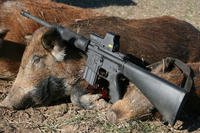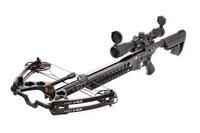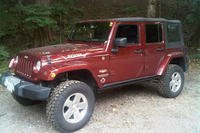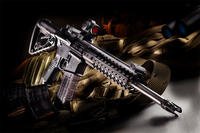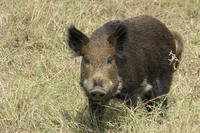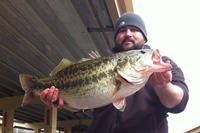The evolution to legitimate hunting rifles.
by Mike Schoby
It was close to 15 years ago when I first carried an AR-15 afield for coyotes. I got some strange looks from local ranchers and even stranger questions from my hunting partners. There were many doubts regarding the accuracy, reliability, looks and overall function of a semi-auto rifle as a hunting tool. Today those questions have pretty much been put to rest. Those that have used AR-style rifles realize that they are very accurate, on par with most bolt-actions, are very reliable, and are unsurpassed in terms of ruggedness.
It is no secret to the predator hunter that the AR-15 style of rifle makes for a near ideal predator rifle. Callers have been using this rifle and extolling its merits for quite some time, but it hasn’t been until recently that the "rest" of the world has caught on. Now it seems everyone is realizing, simultaneously, that this family of rifles are great for hunting. Possibly the biggest "legitimizer" of the AR as a hunting rifle came about from an unlikely source: Big Green. When Remington unveiled its newest centerfire offering, entitled the R-15 VTR, it was a shock for many to learn that it was a hunting colored AR variant.
Remington is not alone in its quest to modify the trusted military arm into a hunting platform. Several companies now offer ARs with custom features as well as field-tested refinements that benefit the hunter. To see what has changed since my first encounter, I took several hunt-ready ARs into the field to put them through their paces.
Remington R-15 VTR
The biggest difference customers see right away with Remington’s intro into the "black gun" market is that it is no longer black. To make it more effective in the field as well as reduce some of the downcast stares, Remington softened the look with a full Realtree Max 1 camo dip. Not only are the results effective for predators, but the overall look is fantastic. It’s apparent at first glance that this rifle is built for the field.
Underneath the dip, the R-15 VTR is a fairly standard, target-grade AR. Out of the box, my R-15 had a reasonably crisp trigger that broke around 4.5 pounds. There was a little overtravel, and some pre-break creep, but nothing that couldn’t be cleaned up by a competent gunsmith or a drop-in replacement trigger such as the ones now offered by Timney. The barrel is 20 inches of matte-blued, fluted carbon steel with a slight target recessed crown. The full-sized A4 stock is comfortable and provides a place for extra gear such as a small cleaning kit, or, extra batteries for flashlights or even a small game call.
The flat-top design is essential on any AR intended to handle a full-sized scope with a medium to large objective lens. You don’t need iron sights on a predator rifle, so why fuss with them — the Remington comes sans sights and no front mounting block — should users ever wish to install iron sights, they’re out of luck. But, since this gun is designed for predator hunting, the need for iron sights is a non-issue.
Smith and Wesson M&P Performance Shop
The Smith and Wesson M&P traces its lineage back to a law enforcement and military background, of which many of the features required serve extremely well for hunters. A soft, finger-grooved rubber rear grip partnered with a skeleton stock covered in foam helps keep weight down while maximizing comfort. The free-floating aluminum hand guard is extended in length offering more room for the off-shooting hand — even when a bipod is installed. These features, while only a small part of the overall package, really do count in the field, making the M&P an effective hunting rifle.
The M&P sports a target-crowned, stainless steel, bull 20-inch barrel with a bead-blasted matte finish to reduce glare. The model I tested, like the other two test models in the group, was set up for a scope with a flat-top receiver without front or rear sights; however, the M&P, unlike the Remington, could be swapped over to iron sights by mounting them to the flat top rear base and front sight base.
The trigger is a two-stage, military-style trigger that was pretty clean while still being safe for use with gloves in cold weather. It broke at about the 4-pound mark, but was crisp without excessive overtravel. To those unaccustomed to two-stage triggers, they might think there is excessive travel before the sear disengages. Once you become familiar with the take-up, then the final pull, you realize how well these triggers can perform.
Rock River Arms Coyote Rifle
This is the only rifle of the group that clearly acknowledges its intended purpose — predator hunting. Of the group, it was my immediate favorite out of the box as it has some great features. Like the other two rifles, it sported a flat-top receiver with no sights. But like the M&P it had a front mounting block so iron sights could be installed. It had a similar grip structure to the Smith and Wesson M&P, which I prefer. The semi-custom pistol grip and skeleton stock made for a great combination, especially when combined with the rubber-coated Hogue free-floating hand guard, which is factory-equipped on the Coyote Rifle. The barrel is a 20-inch matte-blued model with a flash suppressor. But the biggest advantage of the Rock River over the other two models is the oversized trigger guard. ARs traditionally have a relatively small trigger guard opening and that can be a problem when the shooter is wearing heavy winter gloves. The Rock River Coyote Rifle utilizes a uniquely formed lower trigger guard plate that significantly helps open extra room. The factory trigger on this rifle was phenomenal. It’s a traditional military-style two-stage trigger with a very definite take-up and secondary stop. Once you get used to it, it’s not only safe, but easy to use. Once the take-up was removed, the trigger broke clean at just over 3 pounds with very little perceptible creep and only minor overtravel — by far the best of all the triggers tested.
Thoughts on Barrel Twist
It’s important to note that all the rifles tested came from the factory with fast-twist barrels (either 1 in 8 inches or 9 inches). This has become the new standard for the .223 cartridge.
My first .223 years ago was a 1:14 twist that would not stabilize 40-grain bullets. Many rifles were twisted 1:12, which does work well for bullets in the 55-grain weight category. But, designers discovered that a faster 1:9 twist will still shoot lightweight, lower ballistic coefficient (BC) predator bullets as well as a slower twist, but will handle the heavier (up to 80-grain), high BC bullets as well — which is something the slower twists cannot do. A twist of 1:9 is proving to be the most useful.
For most predator hunters this is not a factor, as they are shooting factory fodder with lightweight bullets, but it does make a difference for handloaders. This group knows the downrange potential of heavier bullets with a high BC, especially at longer ranges. Hunters wishing to tackle game larger than coyotes, who want a heavier bullet for penetration, can tailor a load with a much wider spectrum of bullets than a hunter shooting a rifle with a slower rate of twist. The benefits are sometimes limited by the overall length the cartridge can be loaded to for the respective magazine, but the faster twists will stabilize a wider range of heavier bullet weights.
Testing
I based my tests on several quantifiable factors, such as out-of-the-box accuracy, trigger pull, and reliability with factory ammunition. To keep everything standard on the range I choose to use one model of scope, the TRUGLO Infinity Target and Varmint Scope. I have used these scopes on several guns and have been pleased with their reliability, optical clarity and consistency.
At the range, all rifles loaded and functioned the same, and I used one magazine to isolate or minimize any chance of feeding problems using different components. All the guns functioned flawlessly. Unlike AR15s of a generation ago, when GIs bitterly complained about their lack of reliability, modern ARs function just fine. I tested a variety of factory new ammunition (premium hunting loads and standard plinking loads) as well as good quality remanufactured ammunition and experienced not a single failure to feed, or any extraction or ejection problem. With some ammunition, as well as after hard field use and lack of proper cleaning, some jams might crop up, but if the rifle is kept clean and fed well, cycling problems become a moot point.
In the accuracy department, the trio shot extremely well. It used to be a rare bolt-action rifle that would group under an inch at 100 yards, but all the ARs tested did it with at least one style of hunting ammunition. Keep in mind, all rifles were tested with factory ammunition, and no doubt with a little tweaking with handloads, the results could be improved.
Conclusion
All of the rifles performed admirably, with a slight accuracy edge going to the Rock River Coyote rifle. In addition to being a good shooter, it also had other features I liked, such as the skeleton stock, rubber-covered hand guard, large trigger guard and soft pistol grip. If I could offer suggestions, I would lose the flash hider and give the whole gun a camo dip, like the Remington. Not only do I like the look, it does offer an advantage for staying hidden and helps non-black-gun folks see what these rifles can do without letting their misconceptions get in the way.
Chart
Remington R15 VTR
Barrel Length: 20"
Rate of twist: 1 in 9"
Overall Length: 38.5"
Overall Weight: 7.8 lbs.
Trigger: 4.5 lbs.
Best 3-shot group: .92" center center
Misfeeds or other malfunctions: none
Rock River Arms Coyote
Barrel Length 20" Wilson Chromoly HBAR
Rate of twist: 1 in 9"
Overall Length: 38.5"
Overall Weight: 8.4 lbs
Trigger: Two-stage match trigger
Best 3-shot group: .68" center to center
Misfeeds or other malfunctions: none
Smith and Wesson M&P
Barrel Length 20"
Rate of twist: 1 in 8"
Overall Length: 38.5"
Overall Weight: 7.8 lbs
Trigger: Two-stage match grade
Best 3-shot group: .85" center to center
Misfeeds or other malfunctions: none
